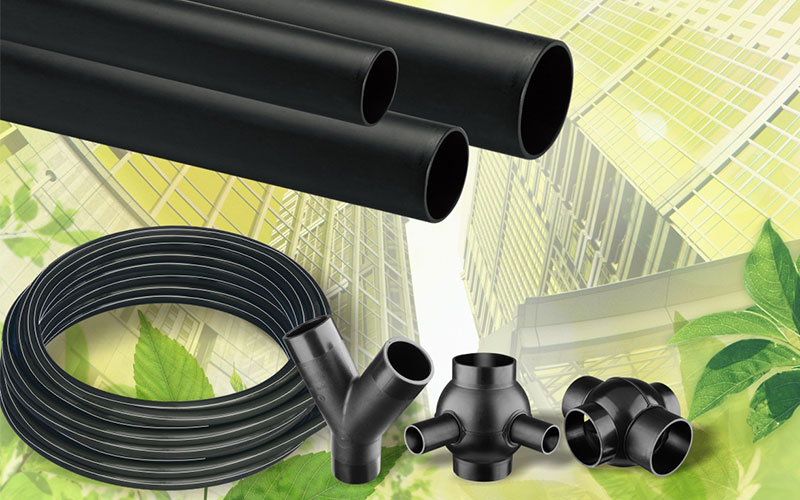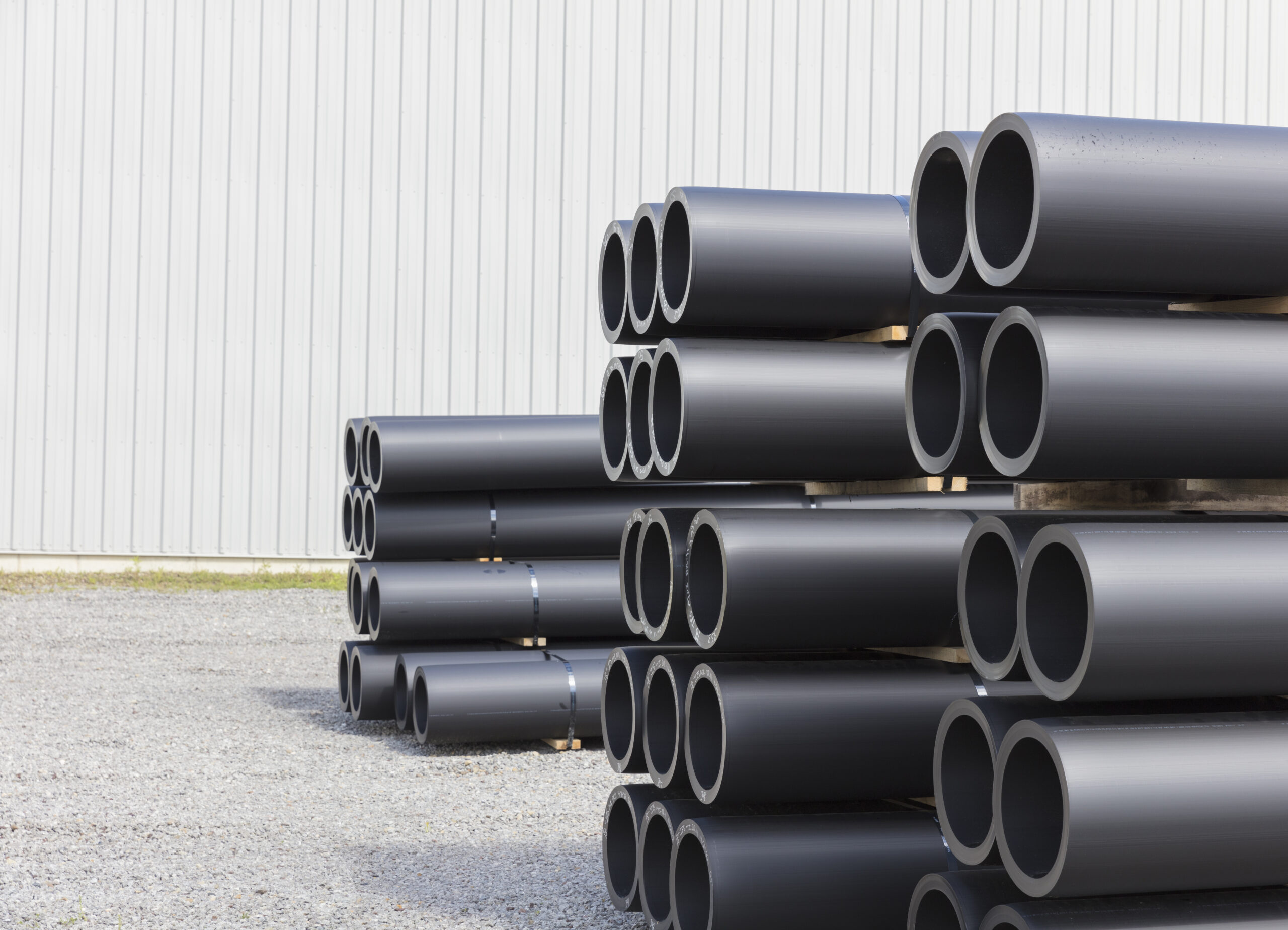How Midland TX HDPE Pipe Fittings in Stock Save Time
Explore the Production Process Behind High-Quality HDPE Pipeline and Its Applications
The manufacturing process of high-grade HDPE pipelines is complex and methodical. It starts with the selection of raw materials that boost performance. Following this, ethylene undertakes polymerization to create material, which is then shaped through extrusion. Quality control is paramount, making certain that the end product fulfills stringent criteria. The journey of HDPE pipes doesn't end with manufacturing. Their applications across different markets disclose a more comprehensive importance worth checking out.
Comprehending HDPE: Features and Advantages

High-density polyethylene (HDPE) is a functional thermoplastic known for its sturdiness and resistance to different environmental variables. This product exhibits excellent tensile toughness, making it appropriate for demanding applications. Its low-density structure adds to a light-weight product, assisting in simplicity of taking care of and setup. HDPE additionally showcases amazing resistance to chemicals, which lessens degradation when subjected to severe compounds.
The product's low dampness absorption better improves its longevity, making it perfect for usage in pipelines and storage space containers. Furthermore, HDPE is immune to ultraviolet (UV) radiation, making certain that products keep their honesty also when revealed to sunshine. Its versatility permits for the production of detailed shapes without jeopardizing toughness. The green nature of HDPE, usually obtained from recycled products, contributes to its allure, promoting sustainable practices in manufacturing. In general, these buildings and advantages make HDPE a favored option for different industrial and consumer applications.
Raw Product Selection for HDPE Manufacturing
The option of basic materials for HDPE production is vital to validate the last item satisfies the wanted specs and quality requirements. High-density polyethylene (HDPE) is primarily produced from polymerized ethylene, originated from nonrenewable fuel sources such as natural gas or unrefined oil. The quality of these feedstocks considerably affects the mechanical and thermal buildings of the last HDPE.
Ingredients likewise play a considerable role in enhancing HDPE's performance, consisting of anti-oxidants, UV stabilizers, and colorants, which improve resilience and resistance to ecological aspects. The option procedure need to think about not only the chemical structure of the raw materials however also their handling attributes to ensure effective manufacturing.
The sourcing of raw materials must focus on sustainability and compliance with environmental laws, as liable methods are vital in today's market. Eventually, careful resources selection lays the foundation for creating high-quality HDPE pipelines ideal for diverse applications.
The Extrusion Refine: Forming HDPE Pipeline
The extrusion procedure plays an important duty fit HDPE pipelines, starting with meticulous material prep work techniques that guarantee excellent flow and uniformity. Similarly essential is the design of the die, which directly affects the last measurements and surface high quality of the pipeline. Together, these aspects add significantly to the efficiency and top quality of HDPE pipe production.
Material Prep Work Strategies
Reliable manufacturing of HDPE pipes begins with precise product prep work methods, particularly the extrusion process. During this stage, high-density polyethylene resin is initial dried to get rid of wetness, ensuring optimal circulation features. The resin is then fed into the extruder, where it goes through home heating and melting, changing into a viscous state. This heating process is thoroughly managed to keep the material's honesty and performance. The liquified HDPE is compelled via a die, forming it into a continuous pipe form. Appropriate temperature monitoring during extrusion is essential, as it straight impacts the product's residential or commercial properties and the last item high quality. Once formed, the HDPE pipeline is cooled and cut to specified sizes, all set get redirected here for subsequent handling and applications.
Die Layout Significance
Accuracy in die design plays an important function in the extrusion process of HDPE pipes. The die functions as the final shaping device, straight influencing the pipe's measurements, wall surface thickness, and surface coating. A well-designed die guarantees uniform material flow, reducing flaws such as abnormalities and vulnerable points. The geometry of the die must be maximized to fit the details homes of HDPE, including its thickness and thermal habits during extrusion. Additionally, the cooling price of the material as it travels through the die can substantially influence the pipe's architectural stability. Spending in sophisticated die modern technology is vital for producers aiming to create top notch HDPE pipelines that fulfill sector criteria and consumer assumptions.
Quality Control Actions in HDPE Manufacturing
Although various aspects influence the quality of HDPE pipeline manufacturing, effective quality assurance procedures are critical to ensure uniformity and reliability in the end product. Trick quality assurance techniques include rigorous material evaluation, validating that the raw polyethylene fulfills recognized criteria for purity and thickness. Throughout the extrusion process, parameters such as temperature level, stress, and cooling time are carefully kept an eye on to keep dimensional precision and architectural stability
Additionally, post-production screening is necessary; makers usually carry out hydrostatic examinations to assess the pipeline's strength and resistance to stress. Visual examinations for surface defects further boost quality control. Qualification from relevant criteria organizations, like ASTM or ISO, gives an extra layer of reputation. By implementing these detailed quality assurance measures, makers can reduce problems, enhance efficiency, and ensure that the HDPE pipelines satisfy the details needs of different applications, ultimately resulting in consumer satisfaction and rely on the product.
Applications of HDPE Pipeline Across Industries
HDPE pipes are made use of throughout various fields as a result of their toughness and flexibility. In water distribution systems, they ensure efficient distribution, while in wastewater management, they provide trusted remedies for waste transportation. Additionally, farming watering networks gain from HDPE's resistance to deterioration and adaptability, making it an optimal choice for modern-day farming practices.

Water Circulation Equipments
A substantial variety of sectors count on high-density polyethylene (HDPE) pipelines for effective water circulation systems. Known for their resilience see this page and resistance to deterioration, HDPE pipelines are widely made use of in community supply of water networks, farming irrigation, and industrial applications. Their light-weight nature helps with very easy handling and installation, lowering labor costs and time. Additionally, HDPE pipes can accommodate numerous stress levels, making them suitable for both reduced and high-pressure systems. hdpe pipe fittings Midland TX. The versatility of the material permits smooth integration right into existing facilities, decreasing the need for considerable excavation. Furthermore, HDPE's resistance to chemical leaching warranties that the water provided stays safe and tidy, making it an excellent selection for keeping the top quality of potable water across different industries
Wastewater Administration Solutions
Efficient water circulation systems also pave the way for innovative wastewater administration solutions, where high-density polyethylene (HDPE) pipes play a significant duty. Popular for their longevity and resistance to deterioration, HDPE pipelines are perfect for delivering wastewater in various setups. Their adaptability permits easy installment in intricate atmospheres, lessening the requirement for extensive excavation. Additionally, HDPE's smooth indoor surface decreases friction, improving flow rates and performance. These pipelines are also immune to chemical leaching, guaranteeing that contaminants do not jeopardize the surrounding setting. Industries, communities, and treatment facilities increasingly rely upon HDPE pipelines for their dependability and long life, making them a preferred choice for contemporary wastewater monitoring systems. This versatility emphasizes the essential value of HDPE pipes throughout many applications.
Agricultural Irrigation Networks
Agricultural irrigation networks benefit substantially from the usage of high-density polyethylene (HDPE) pipes, which supply efficient and trustworthy water distribution to plants. HDPE pipelines are light-weight, making them easy to carry and set up, while their versatility permits for numerous arrangements in diverse surfaces. These pipelines show superb resistance to deterioration, chemicals, and UV radiation, making sure sturdiness in rough farming settings. Additionally, their smooth interior surface area decreases friction loss, maximizing water flow and minimizing energy costs related to pumping. The long life of HDPE pipes, often exceeding 50 years, adds to decrease upkeep and substitute costs. Farmers significantly rely on HDPE pipelines to boost watering efficiency and promote sustainable agricultural practices, ultimately leading to improved crop yields and resource conservation.

Future Fads in HDPE Pipeline Modern Technology
As the demand for lasting and efficient facilities expands, advancements in HDPE pipeline technology are poised to change numerous sectors. Emerging patterns consist of the combination of smart modern technologies, such as sensors and IoT abilities, which help with real-time tracking of pipe conditions, reducing maintenance expenses and protecting against leaks. In addition, the development of advanced production techniques, such as 3D printing, is allowing the production of facility, customized pipeline styles that provide to specific job requirements.
The focus on recycling and round economic situation techniques is driving the innovation of HDPE pipes made from recycled materials, enhancing sustainability. Enhanced jointing approaches, such as electro-fusion and mechanical installations, are likewise enhancing setup efficiency and reliability. Lastly, the growing emphasis on environmental regulations is pressing producers to take on greener manufacturing processes, guaranteeing that HDPE pipes not only satisfy sector standards yet additionally promote an even more lasting future for infrastructure advancement.
Frequently Asked Questions
Exactly How Does HDPE Contrast to Various Other Plastic Products?
HDPE surpasses lots of other plastic materials pertaining to longevity, chemical resistance, and flexibility. Its reduced thickness and high tensile strength make it go to the website optimal for numerous applications, commonly surpassing options in both performance and longevity.
What Are the Environmental Impacts of HDPE Manufacturing?
The environmental influences of HDPE manufacturing include greenhouse gas exhausts, energy consumption, and potential air pollution from producing processes. In addition, incorrect disposal can lead to dirt and water contamination, elevating issues about long-term environmental impacts.
Can HDPE Piping Be Recycled?
Yes, HDPE pipelines can be reused. Numerous facilities approve utilized HDPE for handling, transforming it into brand-new products. This reusing adds to sustainability initiatives, minimizing plastic waste while saving sources and energy in the production cycle.
What Is the Life Expectancy of HDPE Piping?

Just How Do Temperature Level Variants Affect HDPE Pipe Performance?
Temperature variations considerably affect HDPE pipeline performance, affecting versatility and strength. High temperature levels can bring about softening, while reduced temperature levels might cause brittleness, inevitably influencing the pipeline's durability and suitability for numerous applications in varied environments.